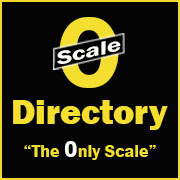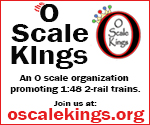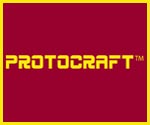1:48 Variations
Definitions by: Lee Schweickart
Traditional O gauge models in the U.S. are built to a scale of 1:48, or ¼ inch per foot, with a track gauge of 11/4 inch.
Tinplate
The term “tinplate” originated with trains manufactured as toys during the 1920s and 30s. Many of the early trains were made of tinplate with lithographed lettering and details.
During the late 30’s most of the major manufacturers began producing much more detailed rolling stock and die cast locomotives, but the “tinplate” name stuck and still is used in referring to three-rail O gauge and to American Flyer two-rail S gauge trains and their accessories.
O and O-27 Three-Rail Tinplate
The “27” in O-27 refers to the 27 inch diameter of a standard circle of track. Both O-27 and O gauge track are 1-1/4” between the outside rails, but traditional O gauge track has a standard circle diameter of 31 inches and is taller and more heavily built than O-27.
O-27 was originally introduced as a smaller, less expensive version of O, with undersize equipment designed to operate on tighter 27” diameter curves. Nearly all O-27 equipment will run on O gauge track, but the larger O gauge cars and locomotives may not perform well through O-27 curves and switches.
Most manufacturers now include several choices of track diameter. The new Atlas line, for example, offers diameters of 27”, 36”, 45”, 54”, 63” and 72” (027, 036, 045, 054, 063 and 072). Several companies offer flexible three rail track so you can build any diameter curve you want.
Lionel, the best known producer of O and O-27 tinplate, went through a difficult period after the founder, Lionel J. Cowen, sold his stock in 1959. Saddled with a series of owners that seemed to be interested only in short-term profit, quality suffered along with sales and the company’s reputation. Today, Lionel is back in the mainstream with advanced technology and a whole range of new ideas and products in addition to many old favorites.
At the same time, Atlas, MTH, Weaver and Williams are providing some stiff competition, improving the quality of their products and offering increased value and a wider selection. Atlas, a major HO manufacturer and a long-time producer/importer of inexpensive two rail O scale, has created a brand new company, Atlas O, devoted to developing an entirely new line of two and three-rail scale locomotives and cars, as well as railroad structures and an innovative new three-rail track system.
Louis Marx & Company stopped production of electric trains in the 1970s, but the Marx name has been revived. Ameritrains produces a specialty line of tin lithographed locomotives, cars, and train sets similar to the original tinplate products, but designed primarily for the collector.
All of this activity has contributed to a surge of interest in three-rail trains, with the potential to recruit an army of youngsters who could become tomorrow’s modelers.
Hi-Rail
Hi-rail is three-rail tinplate, but with emphasis on a more realistic appearance, often including special track work and switches, sometimes with the third rail blackened to make it less obvious.
Atlas, Curtis, Gargraves, MTH, and Ross, all manufacture this type of track. Hi-rail curves are usually broader, scenery and structures are often more detailed, and a serious effort is made to keep everything closer to scale.
While some three-rail cars and engines take obvious liberties with dimensions, design and construction to allow operation on 27” and 31” diameter curves, others are built nearly to scale with very few compromises. Many of these scale and nearly-scale-length models require more generous curves with a diameter of 54” or more. Imported brass models, once manufactured exclusively for two-rail in O scale, are now nearly always available in three-rail as well and may require even larger diameter curves.
O Scale
O scale uses two-rail track with scale length locomotives and cars. Few, if any, compromises are made in the design of scale rolling stock to accommodate sharp curves, so a 36” radius is about as tight as most O scale modelers want to go, even with short switching locomotives and older style 40’ cars.
In O scale, curvature is indicated by radius instead of diameter, which creates no end of confusion for those new to the hobby. A 36” (radius) curve in O scale is the same as a 072 (72” diameter) curve in three rail.
Standard O scale wheel treads and flanges are nearly scale size. The oversize wheels and flanges of three-rail equipment make it easier for children to manipulate and help keep the trains on the rails at high speeds.
Tinplate couplers are much larger and more rugged than scale couplers and are usually mounted on the truck, providing more swing in tight curves. Scale couplers, like the prototype, are mounted on the body of the car.
Track is another obvious difference. Until recently, nearly all three-rail O gauge track was made up of rounded, tubular rail. By contrast, scale rail is solid with a shape and height that matches the prototype.
O scale trains operate on 12 volts direct current (D.C.) while three-rail uses 6 to 20 volts of alternating current (A.C.).
Proto 48
Proto 48 often referred to as P:48, is a relatively new branch of O scale. It’s two-rail in 1/4” scale, but wheel treads and flanges are reduced to exact scale and the track gauge is adjusted from O scale’s traditional 5’ to the actual 4’ 8-1/2” gauge of the prototype. These are, admittedly, fine differences, but the P: 48 modeler’s objective is to build everything as close to scale as possible.
Flex=track is available in Proto 48, but it’s also common to find highly detailed hand-laid track that includes tie plates and all of the other prototype track hardware.
New O scale equipment is often offered in P:48 as well as in standard O, and wheel sets for conversion of existing locomotives and cars are available from several manufacturers.
Narrow Gauge
Narrow gauge can be a pint-size train squealing through impossibly sharp curves in the middle of nowhere or it can be a state-of-the–art electric locomotive hauling ultramodern coaches on a computer controlled railway in the Swiss Alps. Whatever it is, narrow gauge railroads have an undeniable appeal for nearly everyone.
“Gauge” refers to the distance between the rails. Prototype “standard gauge” is generally considered to be 4’ 8-1/2”, but railroads have been built in an astonishing number of different gauges to meet special needs. Some have been wider than today’s standard gauge, but most have been “narrow gauge” with a distance between the railheads of less than 4’ 8-1/2”.
During the railroads building boom of the late 1800’s in the U.S., many new railroads were built as narrow gauge to reduce construction and equipment costs. Most were 3’ but some were 3’6”, 3’2”, 2’6” and 2’ gauge. Short sections of some of these railroads still operate as tourist lines and a substantial amount of original equipment is restored and exhibited in museums.
All scales have a contingent of devoted narrow gauge fans, and O scale is no exception. The most popular O scale narrow gauge in the U.S. is On3 (O scale narrow 3 foot gauge) followed by On30 (30 inch or 2-1/2 foot gauge) and On2 (two foot gauge).
Of course, if you’re modeling O scale narrow gauge you can use any O scale structures, figures, vehicles, or detail parts. Only the track and rolling stock is different.
On3
A good number of small, but reliable suppliers provide imported brass models, structures, locomotives, rolling stock and track. Many On3 modelers concentrate on a favorite railroad, building layouts that represent specific locations with structures, locomotives, cars and other equipment reproduced down to the last nut and bolt.
An immense amount of research has been done on all of the more popular narrow gauge roads. As a result, there’s an abundance of material available, including historical texts, photographs, and detailed plans for nearly any rolling stock or structure that catches your fancy.
On30
While On3 modelers generally stick pretty close to prototype, those in On30 (also referred to as On2-1/2) tend to do whatever works. Very little has been available in 30” narrow gauge, but HO track is close to 30” gauge in O scale and HO car kits and locomotive mechanisms proved a reliable and inexpensive base for building free-lance rolling stock.
Several new products have recently been introduced for On30, including new ready-to-run locomotives, freight, and passenger cars from Bachmann Industries. These developments have attracted a respectable amount of very positive attention from the model railroad press and from veteran modelers who have never seriously considered any form of narrow gauge.
On2
In the U.S., there was a total of about 216 miles of two foot gauge railroads, and most of the two foot common carriers were in Maine. Like the prototype, two foot narrow gauge modelers are a minority within a minority – and many are perfectly content to leave it that way. They tend to be scratch builders with a talent for adapting bits and pieces from other scales and gauges to suit their needs.
A handful of manufacturers and suppliers produce parts, some freight and passenger equipment and occasionally import brass locomotives and cars. Grandt Line offers Porter and Plymouth locomotives in plastic kits and turnouts are available built up or in kit form.
Oe - Om
In Europe and Canada Oe – 1:45 scale with a gauge of 30” is popular as Om – 1:45 scale with a gauge of 22.5 mm representing Swiss meter gauge. In the U.K. they do things a bit differently and the most popular narrow gauge is 1:43 scale with a gauge of 16.5 mm, again representing 30” gauge.
Traction
Traction includes city street car systems, subways and elevated lines as well as high-speed, cross-country interurban and heavy-duty, standard gauge main line railroading. A good variety of equipment is available including poles and fixtures for overhead power supply (catenary), special track and structures.
Most traction modelers operated with power from overhead lines while others build the overhead only for appearance and power their equipment from the track. Some traction fans begin operating with no overhead at all, and then ease into building overhead power lines as their knowledge and confidence grows.
Space Considerations
Q. How much space does O Scale take?
A. As much as you want it to take!
You can fill a basement or a barn for that matter. But you can also have a lot of fun with a three-rail layout on a 4’ x 8’ table. In fact, this is how many of those huge layouts in the magazines started. Remember, three-rail O gauge can use a circle diameter of a little as 27”.
For O scale, P:48, On3, On2 you’ll need a radius of at least 36” (72” diameter) and you’ll be restricted to small locomotives and cars. But that is only if you need curves. Many O Scalers don’t run in circles at all. You can spend hours operating a switching layout – in O scale, P:48, On3 or On2, in a space as small as 2’ wide and 8’ long.
Traction is a different story. Prototype interurban and trolley lines operated with curves tight enough to negotiate street intersections and the same thing can be done in O gauge. A 10” radius is workable and continuous running on a layout two feet wide is not uncommon.
On30 is another special case. With tiny industrial-type locomotives (sometimes referred to as “critters”) and short wheelbase cars, you can get a loop of track and a couple of switches on a 2’ x 4’ base.
National and Local Organizations
No matter which branch of O gauge you’re interested in, it’s easy to find experienced modelers who share your interests and who will be more than willing to provide all the help you need in getting started.
A good way to meet some of these people in your area and to get a handle on what is going on in all areas of the O scale hobby is to join the O Scale Kings (OSK), an association dedcated to helping you find the niche that fits you best. Information on the O Scale Kings and several other O gauge organizations and special interest groups is included in the “Organizations” section of this website or visit the O Scale Kings website.
Join the O Scale Kings







